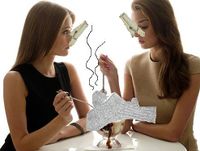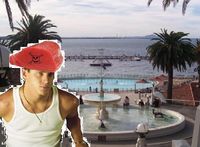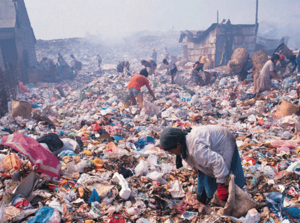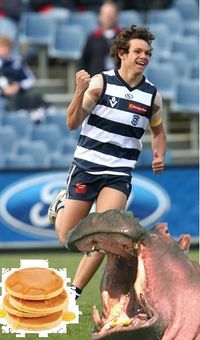Geelong
“Ahehaehaha he's from Geelong!”
– Melbournians
“The bogans of Geelong is their oldest tradition; it has been going on now for three hundred years.”
“For god's sake, shut up about the f*****g bogans!!”
– Geelongites to Tourists
Geelong (pronounced Jill-ong) is a town in South of Victoria, about 80 km from Melbourne. situated on the edge of a gigantic chocolate oreo, the town's main source of commerce is of course tourism, where people come far and wide to sample the region's fine rustic sweaty football socks which are made and fermented by phantom bollards running about in the middle of the night when everyone has gone to bed.
The region is also well-known for its hippopotamus farms, which many tourists come to see in conjunction with a tour of the Ford motor museum; Ford motor company being one of the original industries behind Geelong's growth.
History[edit | edit source]
The exact date of Geelong's establishment is unknown (the date is currently under debate in the Deacon University Campus) and was actually a mistake. Geelong was supposed to be Melbourne but a lack of navigating skills by the founding ship's captain, John Murray, steered his ship towards the useless flat piece of ground which is where Geelong stands today. Geelong then expanded to become the second biggest hole in the state, falling just short of Winchelsea. Many of its municipal buildings are made from solidified sewerage from the nearby Weribee sewerage farm. Almost all of Geelong's building that were built after 1999, were built by the largest population of emus outside of Flinders Street Station.
19th century: White settlement[edit | edit source]
The natives and thus victims of the white settlement are referred to as the 'Wathaurong' people. They populated the area before white-man came.
The word 'Jillong' is a type of aboriginal jelly that the natives made from a mixture of gum leaves and yam-oil.
Governor Richard Burke is credited as the first person who observed that the jelly tasted great with a handful of crumbled oreos thrown on top, so he decided to tell all his friends about it and in no time, Geelong was on the grow.
1850s: Gold rush[edit | edit source]
Apart from the region's fine football socks, the area was host to a surge in Australia's population when in the late-mid 1800s, Gold was found in relative abundance in Belle's rat, just short of an hour's drive north of Geelong. At first, Belle was voraciously opposed to the gold miners who wanted to get inside her furry friend. Her eventual acquiesce was due to a need to finance her pet hippo's Oreo addiction.
1860s: The 'Sleepy Hollow'[edit | edit source]
Ever since 1872, the town has been hosting the annual hippo cup whereupon thousands of Geelongites come together to witness a smorgasboard of the latest in fashion and to trade pancake recipes.
1900s: A city develops[edit | edit source]
Since the early 20th century, Geelong has grown exceptionally, fuelled by its wool and other industries, and is the 12th largest city in Australia. It was officially a city on 8 December 1910, when the first power station was built.
The first of the annual Gala day parades, (which continue to this day) began in 1916, although some Geelongites scoffed at the idea, feigning it was just another excuse to exhibit the latest in bogan fashions.
In the 1930s, Geelong's first radio station, K-Rock (then known as 3GL), commenced, as well as The Great Ocean Road opening and the Eastern Beach was opened after 10 years of work in 1939. Many people decided not to swim there because the water looked like the chocolate river in Willy Wonka's chocolate factory.
1970s: A time of change[edit | edit source]
The original mall opened in 1985 with the other section that became westfield opening in 1988. This is when the first townies started shooting up water from the market square fountain which resulted in countless townies hallucinating oreos chasing them around trying to eat them. This is also the era when the word 'townie' was invented, most likely by somebody who listend to loud, fast music punctuated by screaming electric guitar solos and vocals, and whose predominant choice in footwear is the moccasin.
The problem only worsened until the council destroyed the fountain and put a road and a 7-Eleven there.
21st century[edit | edit source]
The 21st century has seen many things happen for Geelong. Nearby at Avalon, an airport was upgraded to cater for the growing number of tourists wanting to sample the region's sparkling sweaty football socks and abseil the gigantic oreo cookie that fronts the city.
Recently, a 'Save the Oreo' campaign has formed and is taking signatures from passers by just outside the entrance to the mall.
Also, construction began on the new ring-road in 2006, which has since opened and sees daily transport of hundreds of doughnuts to empty stomachs across the region.
Geography[edit | edit source]
Geelong is a city west of Melbourne in Australia, that is at the end of a very long two/one lane freeway. It occasionally provides useful things for the civilised world (i.e. petrol) but mostly its residents just sit there complaining about how they have no water and that the Geelong Bypass should never have been built.
City and suburbs[edit | edit source]
- Belmont
- Break Water (What happens to women when they have babies.)
- Corio
- Marshall (Also Known As Where?)
- Waurn Ponds
- Highton
- East Geelong
- West Geelong
- North Geelong
- Norlane
- Did we say Corio?
- And the Surf Coast (We're trying to claim it!)
- Paraparap
Economy[edit | edit source]
Apart from the Shell refinery in Corio (or Lower Lovely Banks as it is often known) and the Ford manufacturing plant, Geelong lacks any major businesses. This is because most companies know that Geelong is already polluted enough and nobody wants to drive from Melbourne to work there.
Culture[edit | edit source]
There is none.
Art and Music[edit | edit source]
The Barwon Club regularly hosted Magic Dirt before Daniel Herring left the band almost 20 years ago.
There are many art galleries in Geelong with a host of exhibitions and range of styles from contemporary to classic.
Things To Do[edit | edit source]
Many of the older children and teenagers sit at home and read betty crocker magazines and invent new styles of drug cakes; a pasttime classically favoured as much as a drive to the top of the giant oreo for bongs, on a head full of shrooms.
In spite of many people coming to Geelong for a taste of 'the socks' as they are affectionately known, a culinary favourite originating in the Goldfields near Belle's rat.
Infrastructure[edit | edit source]
The Geelong Bypass is due to be completed in 2010 but Braksy and his Spring St n00bs will probably delay it by about 10 more years.
Princes Freeway (A1)[edit | edit source]
The Princes Freeway ends in Geelong and is the cause of the West Gate Bridge toll failing.
Sport[edit | edit source]
The Geelong AFL team, the Cats, are based in Geelong and occasionally go over to Perth or Adelaide to give Freo or Adelaide a thumping.
See also[edit | edit source]
- Werribee Plains, Victoria
- Bogan
- War on Tourism






